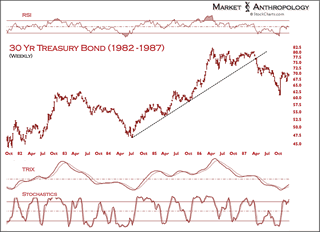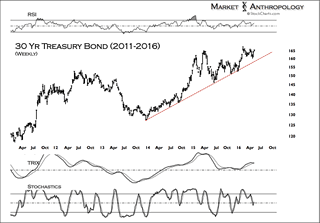Since Treasuries made their respective highs in mid February, we held an intermediate-term outlook that yields could drift higher through the spring, before exogenous market pressures again arose pushing participants back into the safe haven shores of long-term Treasuries. Overall, yields have drifted above their respective lows from February, albeit modestly, and in a flagging and diminishing range from the highs in early March [as can be seen in Figure 1 below].

While the backdrop for long-term Treasuries has largely remained a benevolent place for investors this year, the markets have again traded in a descending range from their February highs, which in the past has presaged a subsequent trend shift lower. Taken in context with the broad range that long-term Treasuries have remained in since their momentum highs back in January 2015, a potential break below support extending from their late December 2013 lows – [they] could accelerate downside pressures and markedly extend our outlook for a rising yield environment beyond Q2.
Considering fund flows this year that have overwhelmingly remained out of equities and into bonds, a major breakdown in Treasuries could result in another rotation back into equities. That said, at this point in the cycle we’re more comfortable speculating on the short-side of Treasuries here, rather than a derivative bet on this potential outcome. [See Figure 2 below.]

One historical period that we have been following for possible insights is the market environment headed into the spring of 1987, where investors had pushed long-term Treasuries significantly higher over the previous two years on the back of a sluggish global economy and a collapse in oil prices. It wasn’t until the global economy stabilized and oil prices began moving higher that the Fed began to raise rates in April 1987. This shift – following several years of dis-inflationary market conditions that had greatly buttressed the trend in Treasuries – came to an abrupt end that spring. Headed into October, the price on the 30-year Treasury bond had fallen by over 20 percent.











Leave A Comment